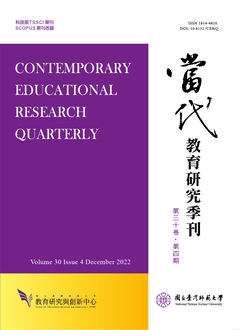

研究目的
本研究系統性的分析一門工學院「創意思維」課程中學生在做專案時,所面臨的環境、行為者以及歷程等三層面的框架,並在歷程層面裡進一步分析四種破框思維(建構思維、辯證思維、對比思維、探索思維)對於學生製做專題的影響,以此分析架構系統性地呈現創意思維之多元對反共構的本質,以作為未來相關課程設計的參考。
研究設計/方法/取徑
以課程中21 名修課學生為研究對象,針對創意思維手冊、期末報告、期末訪談以及問卷等資料,以理論驅動編碼之主題分析為方法進行質性研究,並以問卷之描述性統計為輔助說明。
研究發現或結論
外在環境框架的意義乃由個人心智計算結果所賦予。個人解決強結構性問題的經驗在初期可能會侷限他們對解決弱結構性問題的嘗試意願。運用四種破框思維隨時擾動既有認知基模,能產生創造力所需之建設性張力。學生肯定工程教育中推動創意思維的價值。
研究原創性/價值
以三層面框架與歷程中的四種破框思維,系統性探討創造力多元對反共構思維的本質,為創造力教學相關研究首見的研究角度與分析架構。
教育政策建議或實務意涵
創造力的發展應以問題解決情境下,系統性思考多元或相對想法為趨動,而非僅靠情境抽離式活動來讓學生體驗想法操弄而已。
Purpose
In an “innovative thinking” class offered in the school of engineering, we systematically analyzed how frames manifested themselves at the layers of press, person, and process while students were working on projects. We further explored the influence that adopting four types of frame-breaking thinking—constructionist, dialectical, analogical, and exploratory thinking—might have on the way students conducted their projects. We proposed a framework systematically presenting the Janusian nature of innovative thinking, which could serve as an exemplar for designing innovation development courses for engineering students.
Design/methodology/approach
We conducted a qualitative study featuring theme analyses with theory-driven coding on data (including creative thinking manuals, term reports, and end-of-semester team interviews) collected from 21 students who took the class. We also administered a questionnaire to collect students’ opinions on the course and presented the results of their descriptive statistics.
Findings/results
Students’ mental calculations determine the meanings of the frames from the external press. Personal experiences on wellstructured problems could negatively influence the efficacy of solving ill-structured problems, at least at the beginning of the process. Using four types of frame-breaking thinking to perturb extant cognitive schema may produce the innovative tensions that breed creativity. In addition, descriptive statistics provide evidence for students' approvals on the course's methods and outcomes.
Originality/value
Exploring the nature of Janusian thinking in innovation by systematically investigating the nature of the three-layered frames and the impacts of the four types of frame-breaking thinking presents an analytical framework and a research angle new to the literature.
Suggestions/implications
Innovation development should be driven by systematic operations on diverse or opposing ideas in problem-solving situations rather than activities that manipulate ideas in context-free scenarios.

本著作係採用創用 CC 姓名標示-非商業性 3.0 台灣 授權條款授權.
本刊國立台灣師範大學教育研究與創新中心
106台北市和平東路一段162號 | 電話: 02-7749-3670 | E-mail: cerecerq@gmail.com
教創中心 | 師大 | 電子報 | 線上投審系統
本刊由國家科學及技術委員會人文社會科學研究中心補助經費
© 2014 CERI-NTNU
